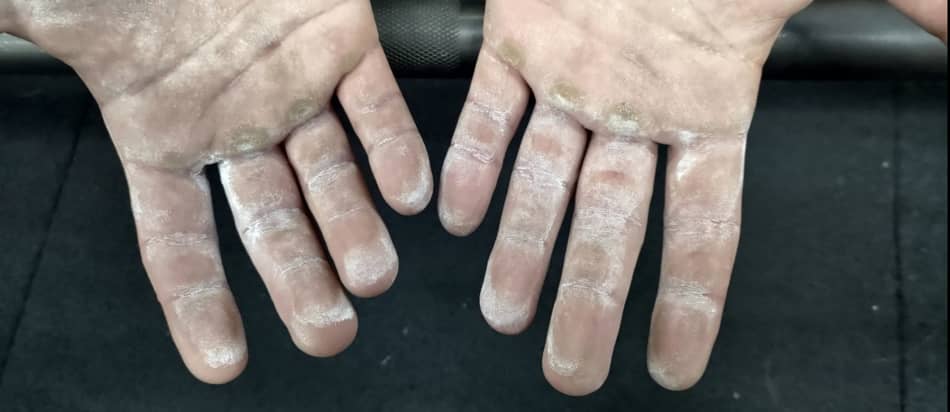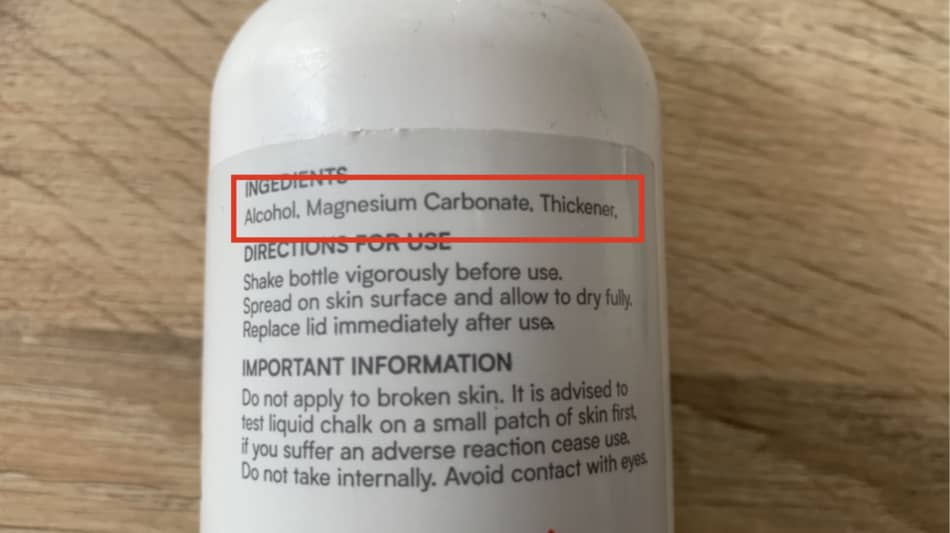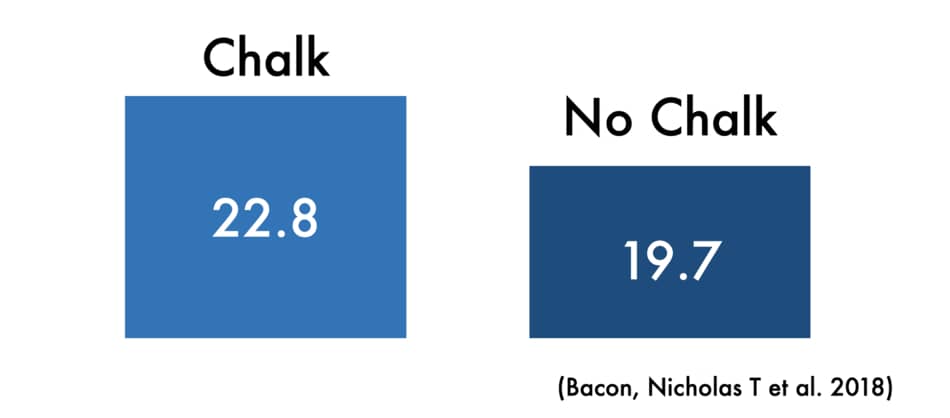Over 6 years ago I started using chalk for all my workouts (both weight lifting and calisthenics) to help dry out the sweat on my hands so that I can get a better grip. However, it did not stop me from developing calluses on my hands (see the picture below).
Today I will explain why both chalk and liquid chalk don’t prevent calluses, and most importantly, what can you do instead.
As a whole, using chalk during weight lifting does not prevent callus formation on your hands. Chalk contains magnesium carbonate to dry the skin, which helps to increase the coefficient of friction. However, it does not reduce direct pressure on the skin, which is the cause of callus formation.

Does Chalk Prevent Calluses?
Overall, chalk helps to diminish hand sweat and improve gripping performance but it does not prevent calluses. The best way to prevent calluses on your hands is to reduce the amount of friction (reduce training volume), change exercises (use more machines instead of free weights), or wear weight lifting gloves which will provide a protective layer between your hands and the weights.
Getting calluses on the hands is a normal physiological response to chronic and excessive pressure or friction on the skin from gripping weights, climbing, gymnastics, and track and field sports.
These calluses are typically found on the skin on your palms (metacarpals, right underneath your fingers).
For guys, developing calluses from weights is like a badge of honor (unless you’re a massage therapist). However, for women, it is bad news because it looks and feels ugly. Over time, the dead skin cells build up and harden to act as a defense mechanism to protect the skin underneath the callus.
Can you prevent a callus from weightlifting?
In general, you can prevent calluses from weightlifting.
A lot of treatments have been shown to help reduce the appearance of the calluses like Epsom salts baths, pumice stones, and hand creams.
However, the easiest way to reduce calluses is to reduce friction (preventing friction is often the only treatment needed).
Does Liquid Chalk Prevent Calluses?
The difference between chalk and liquid chalk is that chalk contains pure magnesium carbonate, whereas liquid chalk contains a mix of magnesium carbonate, alcohol, and other thickeners that dries the hands of sweat.
Here’s photo of my chalk from MyProtein and the list of ingredients it includes.

Similar to powder chalk, liquid chalk does not prevent callus formation on your hands.
To prevent calluses you need something that gives you extra padding or cushion on your hands (e.g. gym gloves). Applying powder or liquid chalk is not enough to minimize friction.
Studies have shown that “magnesium carbonate dries the skin, decreasing its compliance and hence reducing the coefficient of friction” (Li et al. 2001).
What’s better gloves or chalk?
In general, to prevent calluses is much better to use gym gloves rather than chalk because they provide an extra lining between your hands and the weights you lift.
Powder chalk is great to increase the grip and absorb the sweat, but it does not protect your hands from calluses.
I personally prefer using liquid chalk over the powder because it makes less mess, it’s easier to carry in my gym bag and it only requires a drop into my palms to work.
In liquid chalk, the alcohol evaporates in less than a minute and leaves you with evenly chalked-up and dry palms.
That helps to create extra friction evenly throughout the palm and gives me a better grip, especially during pull exercises like pull-ups, deadlifts, and rows.
Does Chalk Make Calluses Worse?
As a whole, using chalk while lifting weights does not make calluses worse, as long as you maintain your training volume.
Using chalk enhances the coefficient of friction between the person’s hand and weights, which makes it easier to perform more repetitions, therefore, can lead to faster development of calluses.
In other words, chalk help you lift more, and you’re able to do more reps and sets, which in itself leads to having more calluses on your hands.
I kid you not.
Dr. Nicholas T. Bacon from the Belmont University in Nashville did an experiment with experienced climbers. All of them were divided into two trials (with and without chalk).
The goal of the study was to assess how using chalk improves the performance of the people (aka how many reps they can do).
See the picture below.

The graph above illustrates the number of reps people were able to make with and without chalk. During the chalk trial, participants were able to perform (on average) 22.8 reps.
During the “no chalk” trial participants did 19.7 (on average) reps.
As you can see, the results have shown that people who used chalk managed to do a higher number of reps in both open-handed weight-assisted pull-ups as well as pinch grip weight-assisted pull-ups (Bacon et al. 2018).
| Exercise | Chalk | No Chalk |
|---|---|---|
| Open-handed weight-assisted pull-ups | 22.8 | 19.7 |
| Pinch grip weight-assisted pull-ups | 14.4 | 9.1 |
Another study showed that using chalk improved dead hang time from 49 to 62 seconds (this is the exercise where you hang from the pull-up bar with your arms straight).
I also noticed that for deadlifts I can lift more weights and for pull-ups I can do more reps (at least 4-5 more per set) with the chalk on my hands.
I also noticed that I got a much better grip with chalk during my ashtanga sessions when I’m doing a downward-facing dog.
(Seriously, if you’re into yoga, I recommend using chalk for downward dog).
My point is that using chalk does not mean you will have more calluses.
However, as long as you reap the benefits of using chalk and start to perform more reps and sets, this in itself can contribute to faster callus formation.
Does Chalk Protect Your Hands?
Chalk powder is primarily made of magnesium carbonate which helps to protect your hands by drying them out and forming a thin barrier between your skin and the weights.
Plus, current studies have shown that chalk has antiseptic and antiviral activity, which means it can protect your hands from viruses.
Let me show you (it may be the coolest thing that I’ve found online).
Dr. Julie L. McAuley and her colleagues from the University of Melbourne and the Peter Doherty Institute for Infection and Immunity in Parkville, Australia have concluded that:
“Addition of chalk before or after virus contact led to a significant reduction in recovery of infectious SARS-CoV-2 and influenza virus. These observations suggest that the use and application of liquid chalk can be an effective and suitable antiseptic for major sporting events, such as the Olympic Games” (McAuley, Julie L et al. 2021).
Crazy, right?
How Do You Prevent Calluses On Hands?
Follow these easy steps to prevent getting calluses on your hands.
- Wear gym gloves (wearing gym gloves not only gives you extra padding to prevent calluses but also absorbs the sweat to your hands do not feel so slippery.
- Use lifting straps (using lifting straps takes the pressure from your palms into your wrist. This not only helps to reduce the friction on your skin but also lifts more weight).
- Keep your hands moisturized (you can apply some hand creams and keep your hands moisturized. Alternatively, you can get regular manicures to help you remove dead skin build-up from your palms).
Conclusion
As a whole, using powder or liquid chalk help to protect the hand thanks to its antiseptic properties but it does not prevent calluses. Calluses on hands are caused by repetitive pressure or friction on the skin. Using chalk helps to minimize the slipperiness from sweat, but it does not help to reduce pressure.
